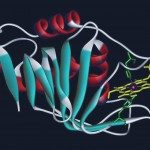Lien vers Pubmed [PMID] – 7558589
Int. J. Pept. Protein Res. 1995 Jun;45(6):574-86
The solution structure of a synthetic 22-amino acid peptide (P1) corresponding to the extreme C-terminal end and one of the F-actin binding sites of villin has been determined by 1H NMR and CD spectroscopy. The structure of this peptide was compared to that of a peptide in which lysine to glutamic acid substitutions were introduced at positions 17 and 19 (P11), abolishing F-actin binding. Both peptides are largely unstructured in aqueous solution. Changes observed in the NMR and CD spectra of both peptides are consistent with alpha-helix formation in trifluoroethanol/water mixtures. A set of 189 interproton distances derived from nuclear Overhauser enhancement (NOE) measurements, 17 phi-angle constraints obtained from 3JNH alpha coupling constants, as well as about 10 N … O distance restraints deduced from amide proton exchange kinetics with deuterium, were used for the structure determination. The three-dimensional structure of P1 and P11 is characterized by two helical regions, one extending from residues 2 to 5 and a second covering residues 7 to 17. The central fragment, ranging from Leu-7 to Leu-15, is more stable. The C-terminal residues are less structured, particularly within peptide P11. The significance of these structural results is discussed in relation to the biological activity of villin.


